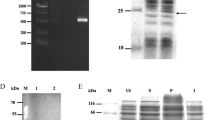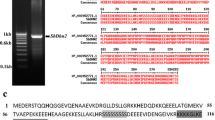Abstract
The wheat dehydrin DHN-5 has been previously shown to exhibit heat protecting effect on enzymatic activities. In order to understand the molecular mechanism by which DHN-5 exerts its protective function, we performed an approach to dissect the functional domains of DHN-5 responsible for this feature. In two distinct enzymatic assays, we found that the truncated forms of DHN-5 containing only one K- or two K-segments are able to protect albeit to less extent than the wild type protein, lactate dehydrogenase and β-glucosidase against damage induced by various stresses in vitro. However, the YS- and Φ-segments alone have no protective effects on these enzymes. Therefore, our study provides the evidence that the protective function of DHN-5 seems to be directly linked to its K-segments which through their amphipatic α-helical structure, may act to prevent protein aggregation.




Similar content being viewed by others
References
Wise, M. J. (2003). LEAping to conclusions: A computational reanalysis of late embryogenesis abundant proteins and their possible roles. BMC Bioinformatics, 4, 52.
Close, T. J. (1996). Dehydrins: Emergence of a biochemical role of a family of plant dehydration proteins. Physiologia Plantarum, 97, 795–803.
Close, T. J. (1997). Dehydrins: A commonality in the presence of plants to dehydration and low temperature. Physiologia Plantarum, 100, 291–296.
Tompa, P., Szász, C., & Buday, L. (2005). Structural disorder throws new light on moonlighting. Trends in Biochemical Sciences, 30, 484–489.
Hanin, M., Brini, F., Ebel, Ch., Toda, Y., Takeda, Sh., & Masmoudi, K. (2011). Plant dehydrins and stress tolerance: Versatile proteins for complex mechanisms. Plant Signaling & Behavior, 6, 1–7.
Kazuoka, T., & Oeda, K. (1994). Purification and characterization of COR85-oligomeric complex from cold acclimated spinach. Plant and Cell Physiology, 35, 601–611.
Houde, M., Daniel, C., Lachapelle, M., Allard, F., Laliberté, S., & Sarhan, F. (1995). Immunolocalization of freezing-tolerance associated proteins in the cytoplasm and nucleoplasm of wheat crown tissues. The Plant Journal, 8, 583–593.
Wisniewski, M., Webb, R., Balsamo, R., Close, T. J., Yu, X. M., & Griffith, M. (1999). Purification, immunolocalization, cryoprotective, and antifreeze activity of PCA60: A dehydrin from peach (Prunus persica). Physiologia Plantarum, 105, 600–608.
Brini, F., Saibi, W., Amara, I., Gargouri, A., Masmoudi, K., & Hanin, M. (2010). The wheat dehydrin DHN-5 exerts a heat-protective effect on β-glucosidase and glucose oxidase activities. Bioscience, Biotechnology, and Biochemistry, 74, 1050–1054.
Hara, M., Terashima, S., & Kuboi, T. (2001). Characterization and cryoprotective activity of cold responsive dehydrin from Citrus unshiu. Journal of Plant Physiology, 158, 1333–1339.
Ellis, R. J. (2004). From chloroplasts to chaperones: How one thing led to another. Photosynthesis Research, 80, 333–343.
Tunnacliffe, A., & Wise, M. J. (2007). The continuing conundrum of the LEA proteins. Naturwissenschaften, 94, 791–812.
Saibi, W., & Gargouri, A. (2011). Purification and biochemical characterization of an atypical β-glucosidase from Stachybotrys microspora. Journal of Molecular Catalysis B-Enzymatic, 72, 107–115.
Tamya, T., Okahashi, N., Sakuma, R., Aoyama, T., Akahane, T., & Matsumoto, J. J. (1985). Freeze denaturation of enzymes and its prevention with additives. Cryobiology, 22, 446–456.
Carpenter, J. F., & Crowe, J. H. (1988). The mechanism of cryoprotection of proteins by solute. Cryobiology, 25, 244–255.
Reyes, J. L., Rodrigo, M. J., Colmenero-Flores, J. M., Gil, J. V., Garay-Arroyo, A., Campos, F., et al. (2005). Hydrophilins from distant organisms can protect enzymatic activities from water limitation effects in vitro. Plant, Cell and Environment, 28, 709–718.
Ingram, J., & Bartels, D. (1996). The molecular basis of dehydration tolerance in plants. Annual Review of Plant Physiology and Plant Molecular Biology, 47, 377–403.
Segrest, J. P., De Jones, M. K., Loof, H., Brouillette, C. G., Venkatachalapathi, Y. V., & Anantharamaiah, G. M. (1992). The amphipathic helix in the exchangeable apolipoproteins: A review of secondary structure and function. Journal of Lipid Research, 33, 141–166.
Tompa, P. (2002). Intrinsically unstructured proteins. Trends in Biochemical Sciences, 27, 527–533.
Kriwacki, R. W., Hengst, L., Tennant, L., Reed, S. I., & Wright, P. E. (1996). Structural studies of p21Waf1/Cip1/Sdi1 in the free and Cdk2-bound state: conformational disorder mediates binding diversity. Proceedings of the National Academy of Sciences USA, 93, 11504–11509.
Hughes, S., & Graether, S. P. (2011). Cryoprotective mechanism of a small intrinsically disordered dehydrin protein. Protein Science, 20, 42–50.
Zheng, Y. B., Meng, F. G., Chen, B. Y., & Wang, X. C. (2002). Inactivation and conformational changes of lactate dehydrogenase from porcine heart in sodium dodecyl sulphate solutions. International Journal of Biological Macromolecules, 31, 97–102.
Goyal, K., Walton, L. J., & Tunnacliffe, A. (2005). LEA proteins prevent protein aggregation due to water stress. Biochemical Journal, 388, 151–157.
Bai, J. H., Wang, H. J., & Zhou, H. M. (1998). Alkaline-induced unfolding and salt-induced folding of pig heart lactate dehydrogenase under high pH conditions. International Journal of Biological Macromolecules, 23, 127–133.
Gabellieri, E., & Strambini, G. B. (2006). ANS fluorescence detects widespread perturbations of protein tertiary structure in ice. Biophysical Journal, 90, 3239–3245.
Reyes, J. L., Campos, F., Wei, H., Arora, R., Yang, Y., Karlson, D. T., et al. (2008). Functional dissection of hydrophilins during in vitro freeze protection. Plant, Cell and Environment, 31, 1781–1790.
Acknowledgments
This study was supported by grants from the Ministry of Higher Education and Scientific Research, Tunisia.
Author information
Authors and Affiliations
Corresponding author
Rights and permissions
About this article
Cite this article
Drira, M., Saibi, W., Brini, F. et al. The K-Segments of the Wheat Dehydrin DHN-5 are Essential for the Protection of Lactate Dehydrogenase and β-Glucosidase Activities In Vitro. Mol Biotechnol 54, 643–650 (2013). https://doi.org/10.1007/s12033-012-9606-8
Published:
Issue Date:
DOI: https://doi.org/10.1007/s12033-012-9606-8




